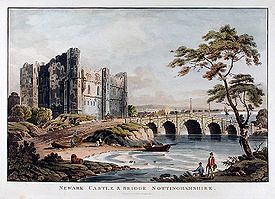
Newark Castle, Nottinghamshire
Encyclopedia

Newark-on-Trent
Newark-on-Trent is a market town in Nottinghamshire in the East Midlands region of England. It stands on the River Trent, the A1 , and the East Coast Main Line railway. The origins of the town are possibly Roman as it lies on an important Roman road, the Fosse Way...
, in the English county of Nottinghamshire
Nottinghamshire
Nottinghamshire is a county in the East Midlands of England, bordering South Yorkshire to the north-west, Lincolnshire to the east, Leicestershire to the south, and Derbyshire to the west...
was built by Alexander
Alexander of Lincoln
Alexander of Lincoln was a medieval English Bishop of Lincoln, a member of an important administrative and ecclesiastical family. He was the nephew of Roger of Salisbury, a Bishop of Salisbury and Chancellor of England under King Henry I, and he was also related to Nigel, Bishop of Ely...
, consecrated Bishop of Lincoln
Bishop of Lincoln
The Bishop of Lincoln is the Ordinary of the Church of England Diocese of Lincoln in the Province of Canterbury.The present diocese covers the county of Lincolnshire and the unitary authority areas of North Lincolnshire and North East Lincolnshire. The Bishop's seat is located in the Cathedral...
in 1123, who established it as a mint
Mint (coin)
A mint is an industrial facility which manufactures coins for currency.The history of mints correlates closely with the history of coins. One difference is that the history of the mint is usually closely tied to the political situation of an era...
. His rebuild here was probably the model for that at Sleaford Castle
Sleaford Castle
Sleaford Castle is a medieval castle in Sleaford, Lincolnshire, England. Built by the Bishop of Lincoln in the early 1120s it was inhabitable as late as 1555 but fell into disrepair during the latter half of the 16th-century...
, also built by Alexander.
It rises picturesquely from the river, and from its position and great strength was for a long time known as the 'Key of the North'. Of the original Norman
Norman architecture
About|Romanesque architecture, primarily English|other buildings in Normandy|Architecture of Normandy.File:Durham Cathedral. Nave by James Valentine c.1890.jpg|thumb|200px|The nave of Durham Cathedral demonstrates the characteristic round arched style, though use of shallow pointed arches above the...
stronghold the most important remains are the gate-house, a crypt
Crypt
In architecture, a crypt is a stone chamber or vault beneath the floor of a burial vault possibly containing sarcophagi, coffins or relics....
and the lofty rectangular tower at the south-west angle. The building seems to have been reconstructed in the early part of the 13th century. King John of England
John of England
John , also known as John Lackland , was King of England from 6 April 1199 until his death...
died at this castle on the night of 18 October 1216. In the reign of Edward III
Edward III of England
Edward III was King of England from 1327 until his death and is noted for his military success. Restoring royal authority after the disastrous reign of his father, Edward II, Edward III went on to transform the Kingdom of England into one of the most formidable military powers in Europe...
it was used as a state prison.
During the English Civil War
English Civil War
The English Civil War was a series of armed conflicts and political machinations between Parliamentarians and Royalists...
it was garrisoned for Charles I
Charles I of England
Charles I was King of England, King of Scotland, and King of Ireland from 27 March 1625 until his execution in 1649. Charles engaged in a struggle for power with the Parliament of England, attempting to obtain royal revenue whilst Parliament sought to curb his Royal prerogative which Charles...
, and endured three sieges. Its dismantling was begun in 1646, immediately after the surrender of the king.


